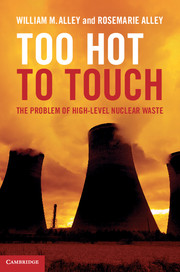Book contents
- Frontmatter
- Contents
- Acknowledgments
- List of units
- List of abbreviations
- Introduction
- Part I The problem
- 1 The awakening
- 2 Brainstorming
- 3 The ocean as a dumping ground
- 4 Radioactivity and atomic energy
- 5 The Cold War legacy
- 6 The peaceful atom and its wastes
- 7 Recycling
- 8 Dry cask storage
- 9 Interim storage
- 10 A can of worms
- 11 WIPP
- Part II The mountain
- Part III No solution in sight
- Appendix Discussion questions
- References
- Index
5 - The Cold War legacy
from Part I - The problem
Published online by Cambridge University Press: 05 February 2013
- Frontmatter
- Contents
- Acknowledgments
- List of units
- List of abbreviations
- Introduction
- Part I The problem
- 1 The awakening
- 2 Brainstorming
- 3 The ocean as a dumping ground
- 4 Radioactivity and atomic energy
- 5 The Cold War legacy
- 6 The peaceful atom and its wastes
- 7 Recycling
- 8 Dry cask storage
- 9 Interim storage
- 10 A can of worms
- 11 WIPP
- Part II The mountain
- Part III No solution in sight
- Appendix Discussion questions
- References
- Index
Summary
In the councils of government, we must guard against the acquisition of unwarranted influence, whether sought or unsought, by the military industrial complex.
President Dwight D. Eisenhower's last State of the Union Address, January 17, 1961The Manhattan Project was the largest, most complex project in human history. The endeavor took place at sites across the United States, Canada, and the United Kingdom, but most of the work occurred at three secret locations. Uranium was enriched at the Oak Ridge Reservation, nestled in the Appalachian valley and ridge province about six miles west of Knoxville, Tennessee. Plutonium was created and processed at the Hanford Reservation, along the Columbia River in southeastern Washington. Nuclear weapons were designed and manufactured at Los Alamos National Laboratory, location of a former boys' school on a remote mesa in New Mexico.
The monumental enterprise to produce nuclear weapons expanded during the Cold War. The Savannah River site, near Aiken, South Carolina, was established in 1950 to increase production of plutonium and tritium for use in nuclear weapons. Lawrence Livermore National Laboratory, built near California farming country, became the Nation’s second weapons-design laboratory to hasten development of the thermonuclear bomb. Plutonium was machined into bomb components at Rocky Flats, Colorado. Nuclear weapons were assembled (and later disassembled) at the Pantex Plant, 17 miles (27 km) northeast of Amarillo, Texas. Altogether the Department of Energy (DOE) weapons complex, as it has come to be known, encompassed more than 100 sites distributed among 31 States and one territory. Individual sites range in size from a few acres to hundreds of square miles. The entire complex covers more than two million acres (800,000 hectares).
- Type
- Chapter
- Information
- Too Hot to TouchThe Problem of High-Level Nuclear Waste, pp. 60 - 83Publisher: Cambridge University PressPrint publication year: 2012



